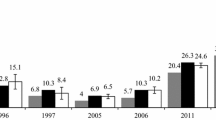Abstract
The seabird tick Ixodes uriae (White) is common in subantarctic areas and is likely to be a vector of pathogenic agents. This paper reports on the prevalence of tick-infested adult king penguins (Aptenodytes patagonicus) and on antibodies to the Lyme disease agent (Borrelia burgdorferi sensu lato) in adult and chick penguins. Fifteen percent of the adults of the colony studied were tick infested. B. burgdorferi antibodies were detected in 14% of tick-infested adults' and in 6% of chicks' sera. The percentage of tick-infested adults differed significantly according to location in the colony, the highest density occurring on the upper slopes of the colony. The potential role of king penguins as B. burgdorferi reservoirs and the effect of this agent on king penguin populations remain unknown. The consequences for human health are discussed.
Similar content being viewed by others
Author information
Authors and Affiliations
Additional information
Accepted: 15 March 1999
Rights and permissions
About this article
Cite this article
Gauthier-Clerc, M., Jaulhac, B., Frenot, Y. et al. Prevalence of Borrelia burgdorferi (the Lyme disease agent) antibodies in king penguin Aptenodytes patagonicus in Crozet Archipelago. Polar Biol 22, 141–143 (1999). https://doi.org/10.1007/s003000050402
Issue Date:
DOI: https://doi.org/10.1007/s003000050402




